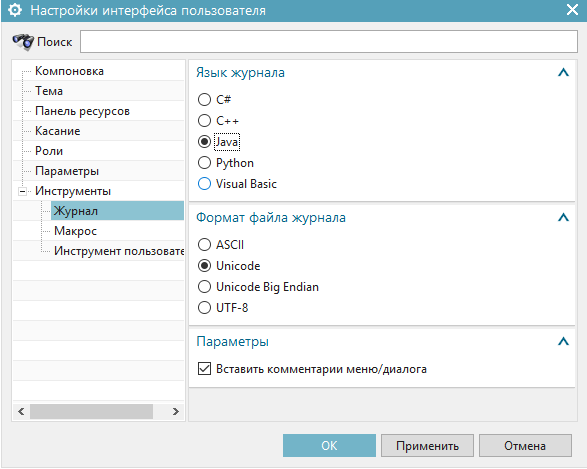可以在官方网站上找到有关NXOpen库的必要信息。
NX根文件夹包含我们需要的默认库以及示例:
- C:\ Program Files文件\ Siemens \ NX 12.0 \ NXBIN带jar扩展名
- C:\ Program Files文件\ Siemens \ NX 12.0 \ UGOPEN带jar扩展名
- C:\ Program Files \ Siemens \ NX 12.0 \ UGOPEN \ SampleNXOpenApplications \ Java。
为了简化代码编写,您可以将操作日志记录到文本文件中作为基础。默认情况下,Unigraphics NX以Visual Basic语言编写,但是在设置中,您可以将其更改为Java或可用列表中的任何其他语言:

这是登录文本文件的示例。
代码清单
// NX 12.0.1.7
// Journal created by Aleksandr on Sun Nov 3 19:49:32 2019 RTZ 2 ()
//
import nxopen.*;
public class journalTT
{
public static void main(String [] args) throws NXException, java.rmi.RemoteException
{
nxopen.Session theSession = (nxopen.Session)nxopen.SessionFactory.get("Session");
nxopen.cae.FemPart workFemPart = ((nxopen.cae.FemPart)theSession.parts().baseWork());
nxopen.cae.FemPart displayFemPart = ((nxopen.cae.FemPart)theSession.parts().baseDisplay());
// ----------------------------------------------
// : ->->2D ...
// ----------------------------------------------
int markId1;
markId1 = theSession.setUndoMark(nxopen.Session.MarkVisibility.VISIBLE, "");
nxopen.cae.FEModel fEModel1 = ((nxopen.cae.FEModel)workFemPart.findObject("FEModel"));
nxopen.cae.MeshManager meshManager1 = ((nxopen.cae.MeshManager)fEModel1.find("MeshManager"));
nxopen.cae.Mesh2d nullNXOpen_CAE_Mesh2d = null;
nxopen.cae.Mesh2dBuilder mesh2dBuilder1;
mesh2dBuilder1 = meshManager1.createMesh2dBuilder(nullNXOpen_CAE_Mesh2d);
nxopen.cae.MeshCollector nullNXOpen_CAE_MeshCollector = null;
mesh2dBuilder1.elementType().destinationCollector().setElementContainer(nullNXOpen_CAE_MeshCollector);
mesh2dBuilder1.elementType().setElementTypeName("CQUAD4");
nxopen.Unit unit1 = ((nxopen.Unit)workFemPart.unitCollection().findObject("MilliMeter"));
mesh2dBuilder1.propertyTable().setBaseScalarWithDataPropertyValue("quad mesh overall edge size", "10", unit1);
mesh2dBuilder1.propertyTable().setBooleanPropertyValue("target minimum element edge length", false);
mesh2dBuilder1.propertyTable().setBaseScalarWithDataPropertyValue("surface curvature threshold", "5.05", unit1);
nxopen.Unit nullNXOpen_Unit = null;
mesh2dBuilder1.propertyTable().setBaseScalarWithDataPropertyValue("small feature value", "1", nullNXOpen_Unit);
theSession.setUndoMarkName(markId1, " 2D ");
nxopen.DisplayableObject [] objects1 = new nxopen.DisplayableObject[1];
nxopen.cae.CAEBody cAEBody1 = ((nxopen.cae.CAEBody)workFemPart.findObject("CAE_Body(14)"));
nxopen.cae.CAEFace cAEFace1 = ((nxopen.cae.CAEFace)cAEBody1.findObject("CAE_Face(14)"));
objects1[0] = cAEFace1;
boolean added1;
added1 = mesh2dBuilder1.selectionList().add(objects1);
nxopen.DisplayableObject [] objects2 = new nxopen.DisplayableObject[1];
nxopen.cae.CAEBody cAEBody2 = ((nxopen.cae.CAEBody)workFemPart.findObject("CAE_Body(3)"));
nxopen.cae.CAEFace cAEFace2 = ((nxopen.cae.CAEFace)cAEBody2.findObject("CAE_Face(3)"));
objects2[0] = cAEFace2;
boolean added2;
added2 = mesh2dBuilder1.selectionList().add(objects2);
nxopen.DisplayableObject [] objects3 = new nxopen.DisplayableObject[1];
nxopen.cae.CAEBody cAEBody3 = ((nxopen.cae.CAEBody)workFemPart.findObject("CAE_Body(2)"));
nxopen.cae.CAEFace cAEFace3 = ((nxopen.cae.CAEFace)cAEBody3.findObject("CAE_Face(2)"));
objects3[0] = cAEFace3;
boolean added3;
added3 = mesh2dBuilder1.selectionList().add(objects3);
nxopen.DisplayableObject [] objects4 = new nxopen.DisplayableObject[1];
nxopen.cae.CAEBody cAEBody4 = ((nxopen.cae.CAEBody)workFemPart.findObject("CAE_Body(1)"));
nxopen.cae.CAEFace cAEFace4 = ((nxopen.cae.CAEFace)cAEBody4.findObject("CAE_Face(1)"));
objects4[0] = cAEFace4;
boolean added4;
added4 = mesh2dBuilder1.selectionList().add(objects4);
int markId2;
markId2 = theSession.setUndoMark(nxopen.Session.MarkVisibility.INVISIBLE, "2D ");
theSession.deleteUndoMark(markId2, null);
int markId3;
markId3 = theSession.setUndoMark(nxopen.Session.MarkVisibility.INVISIBLE, "2D ");
mesh2dBuilder1.setAutoResetOption(false);
mesh2dBuilder1.elementType().setElementDimension(nxopen.cae.ElementTypeBuilder.ElementType.SHELL);
mesh2dBuilder1.elementType().setElementTypeName("CQUAD4");
nxopen.cae.DestinationCollectorBuilder destinationCollectorBuilder1;
destinationCollectorBuilder1 = mesh2dBuilder1.elementType().destinationCollector();
destinationCollectorBuilder1.setElementContainer(nullNXOpen_CAE_MeshCollector);
destinationCollectorBuilder1.setAutomaticMode(true);
mesh2dBuilder1.propertyTable().setIntegerPropertyValue("meshing method", 0);
mesh2dBuilder1.propertyTable().setBaseScalarWithDataPropertyValue("quad mesh overall edge size", "10", unit1);
mesh2dBuilder1.propertyTable().setBooleanPropertyValue("block decomposition option bool", false);
mesh2dBuilder1.propertyTable().setBooleanPropertyValue("mapped mesh option bool", false);
mesh2dBuilder1.propertyTable().setIntegerPropertyValue("fillet num elements", 3);
mesh2dBuilder1.propertyTable().setIntegerPropertyValue("num elements on cylinder circumference", 6);
mesh2dBuilder1.propertyTable().setBaseScalarWithDataPropertyValue("element size on cylinder height", "1", unit1);
mesh2dBuilder1.propertyTable().setIntegerPropertyValue("quad only option", 0);
mesh2dBuilder1.propertyTable().setBooleanPropertyValue("mesh individual faces option bool", false);
mesh2dBuilder1.propertyTable().setIntegerPropertyValue("midnodes", 0);
mesh2dBuilder1.propertyTable().setBooleanPropertyValue("geometry tolerance option bool", false);
mesh2dBuilder1.propertyTable().setBaseScalarWithDataPropertyValue("geometry tolerance", "0", unit1);
mesh2dBuilder1.propertyTable().setBooleanPropertyValue("target maximum element edge length bool", false);
mesh2dBuilder1.propertyTable().setBaseScalarWithDataPropertyValue("maximum element edge length", "1", unit1);
mesh2dBuilder1.propertyTable().setBooleanPropertyValue("target minimum element edge length", false);
mesh2dBuilder1.propertyTable().setBooleanPropertyValue("split poor quads bool", false);
mesh2dBuilder1.propertyTable().setBooleanPropertyValue("move nodes off geometry bool", false);
mesh2dBuilder1.propertyTable().setBooleanPropertyValue("max quad warp option bool", false);
mesh2dBuilder1.propertyTable().setBaseScalarWithDataPropertyValue("max quad warp", "5", nullNXOpen_Unit);
mesh2dBuilder1.propertyTable().setBaseScalarWithDataPropertyValue("max jacobian", "5", nullNXOpen_Unit);
mesh2dBuilder1.propertyTable().setBooleanPropertyValue("target element skew bool", false);
mesh2dBuilder1.propertyTable().setBaseScalarWithDataPropertyValue("element skew", "30", nullNXOpen_Unit);
mesh2dBuilder1.propertyTable().setBooleanPropertyValue("max included angle quad option bool", false);
nxopen.Unit unit2 = ((nxopen.Unit)workFemPart.unitCollection().findObject("Degrees"));
mesh2dBuilder1.propertyTable().setBaseScalarWithDataPropertyValue("max included angle quad", "150", unit2);
mesh2dBuilder1.propertyTable().setBooleanPropertyValue("min included angle quad option bool", false);
mesh2dBuilder1.propertyTable().setBaseScalarWithDataPropertyValue("min included angle quad", "30", unit2);
mesh2dBuilder1.propertyTable().setBooleanPropertyValue("max included angle tria option bool", false);
mesh2dBuilder1.propertyTable().setBaseScalarWithDataPropertyValue("max included angle tria", "150", unit2);
mesh2dBuilder1.propertyTable().setBooleanPropertyValue("min included angle tria option bool", false);
mesh2dBuilder1.propertyTable().setBaseScalarWithDataPropertyValue("min included angle tria", "30", unit2);
mesh2dBuilder1.propertyTable().setBooleanPropertyValue("mesh transition bool", false);
mesh2dBuilder1.propertyTable().setBaseScalarWithDataPropertyValue("mesh size variation", "50", nullNXOpen_Unit);
mesh2dBuilder1.propertyTable().setBaseScalarWithDataPropertyValue("surface curvature threshold", "5.05", unit1);
mesh2dBuilder1.propertyTable().setBooleanPropertyValue("alternate feature abstraction bool", false);
mesh2dBuilder1.propertyTable().setBaseScalarWithDataPropertyValue("minimum feature element size", "0.001", unit1);
mesh2dBuilder1.propertyTable().setBaseScalarWithDataPropertyValue("small feature tolerance", "10", nullNXOpen_Unit);
mesh2dBuilder1.propertyTable().setBaseScalarWithDataPropertyValue("small feature value", "1", nullNXOpen_Unit);
mesh2dBuilder1.propertyTable().setBooleanPropertyValue("suppress hole option bool", false);
mesh2dBuilder1.propertyTable().setBaseScalarWithDataPropertyValue("hole diameter tolerance", "0", unit1);
mesh2dBuilder1.propertyTable().setIntegerPropertyValue("hole suppresion point type", 0);
mesh2dBuilder1.propertyTable().setBooleanPropertyValue("merge edge toggle bool", false);
mesh2dBuilder1.propertyTable().setBaseScalarWithDataPropertyValue("edge angle", "15", unit2);
mesh2dBuilder1.propertyTable().setBooleanPropertyValue("quad mesh edge match toggle", false);
mesh2dBuilder1.propertyTable().setBaseScalarWithDataPropertyValue("quad mesh edge match tolerance", "0.02", unit1);
mesh2dBuilder1.propertyTable().setBaseScalarWithDataPropertyValue("quad mesh smoothness tolerance", "0.01", unit1);
mesh2dBuilder1.propertyTable().setBaseScalarWithDataPropertyValue("quad mesh surface match tolerance", "0.001", unit1);
mesh2dBuilder1.propertyTable().setIntegerPropertyValue("quad mesh transitional rows", 3);
mesh2dBuilder1.propertyTable().setBaseScalarWithDataPropertyValue("min face angle", "20", unit2);
mesh2dBuilder1.propertyTable().setIntegerPropertyValue("mesh time stamp", 0);
mesh2dBuilder1.propertyTable().setBaseScalarWithDataPropertyValue("quad mesh node coincidence tolerance", "0.0001", unit1);
mesh2dBuilder1.propertyTable().setIntegerPropertyValue("mesh edit allowed", 0);
mesh2dBuilder1.propertyTable().setIntegerPropertyValue("transition edge seeding", 0);
mesh2dBuilder1.propertyTable().setIntegerPropertyValue("cylinder curved end num elements", 6);
int id1;
id1 = theSession.newestVisibleUndoMark();
int nErrs1;
nErrs1 = theSession.updateManager().doUpdate(id1);
nxopen.cae.Mesh [] meshes1 ;
meshes1 = mesh2dBuilder1.commitMesh();
theSession.deleteUndoMark(markId3, null);
theSession.setUndoMarkName(id1, "2D ");
mesh2dBuilder1.destroy();
// ----------------------------------------------
// : -> ->3
// ----------------------------------------------
// ----------------------------------------------
// : ->->
// ----------------------------------------------
}
public static final int getUnloadOption() { return nxopen.BaseSession.LibraryUnloadOption.IMMEDIATELY; }
}
}现在,它仅在代码中指定的那些表面上构建网格,并且如果它们数量较少或更多,并且它们的名称不同,则在运行我们的代码时nx会给出错误。因此,我们需要通过在代码中添加try / catch异常来完善代码,并提出一种方法,使我们不会绑定到多边形面的数量。
我这样做是这样的:
try {
for (int i = 1; i < 20; i++) {
obj="object"+i;
cAEB="cAEBody"+i;
cAEF="cAEFace"+i;
adde="added"+i;
//Object objects = new Object();
nxopen.DisplayableObject [] obj = new nxopen.DisplayableObject[1];
nxopen.cae.CAEBody cAEB = ((nxopen.cae.CAEBody)workFemPart.findObject(("CAE_Body"+"("+i+")")));
nxopen.cae.CAEFace cAEF = ((nxopen.cae.CAEFace)cAEB.findObject("CAE_Face"+"("+i+")"));
obj[0] = cAEF;
boolean adde;
adde = mesh2dBuilder1.selectionList().add(obj);
}
} catch (Exception ex) {这是程序中执行的最终结果:
